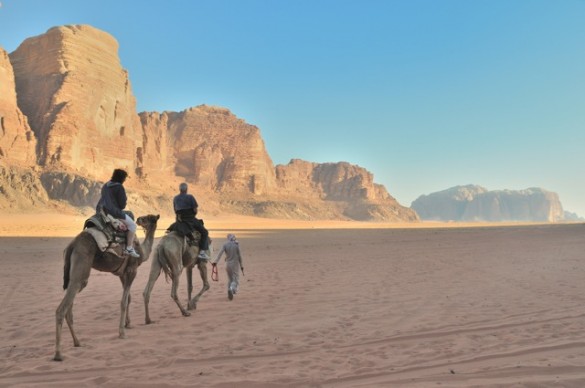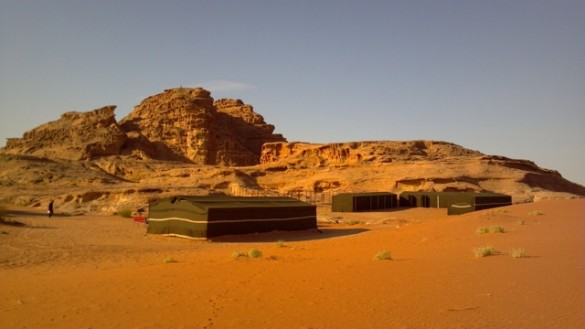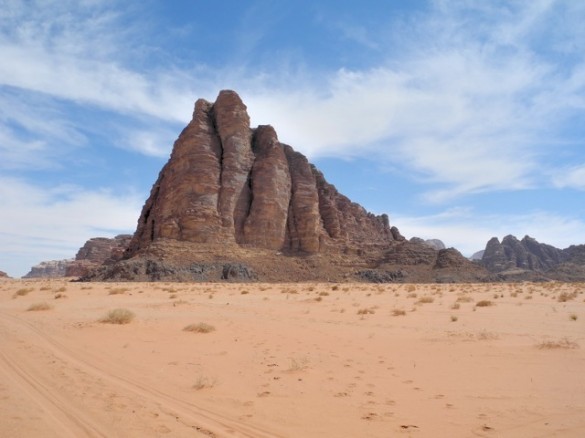With the help of two Bedouin men from camp, I mount Aljan, grasping the wooden post attached to the seat with both hands to maintain balance as he shimmies and shakes his way to a standing position. A large, calm, 21-year-old camel, Aljan is light beige, almost white, in color.
My wife, Terri, waits her turn before climbing aboard Samhan, a much smaller grayish animal, and considerably more cantankerous than his older companion. Coaxed into a sitting position, Samhan snarls as Terri approaches.
As we set out in the direction of our campsite, the two camels are tethered together and led on foot by our guide for what will be an hour-long ride. Our friends Gregory and Janet, who live and work in Aqaba and arranged our itinerary, race alongside us, snapping photos, before we recede into the vastness of the desert.
An expansive desert landscape, interspersed with sheer-sided cliffs, unravels before us. Multi-colored sandstone and granite rock formations rise from the pink sand like towering monuments. We might as well be in a set for Lawrence of Arabia, as this is the land where the famed British officer led the fight against the Ottoman Turks during the Arab uprising of 1916-18. T. E. Lawrence became a legendary figure for his role as liaison officer with rebel forces in the fight for the Arab cause, and made his headquarters at Wadi Rum among the Bedouin nomads. Today, this is still the land of the Bedouin, their oblong, goat-haired tents sprinkled throughout the landscape.

The ride to the Bedouin campsite where we’ll be spending the night is three and one-half hours by camel. We opted for a one-hour ride because our middle-aged muscles can absorb only so much bouncing and pounding aboard our desert taxis. We plan to complete the remainder of the journey by jeep. In this way we will assure our arrival at Moon Valley Camp by sunset. The camp is situated in an area renowned for its stunning sunset views.
It’s November and the sun will set before 5pm, so time is of the essence. Aljan stops often, nibbling at the occasional clusters of grass. Samhan keeps poking his head against my foot and I worry about a twisted ankle. The sun is already low in the sky and the colors of the rock formations have melded from gray and brown to shades of orange and gold.
I ask our guide whether snakes and scorpions pose a danger at camp. The creature I fear most is the Arabian Horned Viper, a snake with horns that resemble large ears. I read somewhere that if you get bitten by one of those, and there’s no anti-snake bite venom around, you might as well say good-bye to the world. Scorpions, of which there are several species, can cause a fair share of misery as well.
“They’ve been about,” he says, “but it’s too cold for them now. They are sleeping at night.” Instantly, I feel better.
Our guide phones ahead to arrange a pick-up spot so we can be driven the rest of the way to camp. There, we will meet up with Gregory and Janet and our mutual friend, Jane. They will join us for dinner and then head back to Aqaba. Terri and I will stay overnight in a tent. Bedouin camps with large black tents partitioned into small compartments are the only type of accommodation at Wadi Rum. Tomorrow, Janet and Jane will fetch us in the small village at noon and from there the four of us will proceed to Petra.
The impetus for our Jordan excursion is to visit our friends and take in the major sights that Jordan has to offer: Aqaba, Wadi Rum, Petra, the Dead Sea, Amman, and Jerash. We had already spent a week in Israel before crossing into Jordan by way of Aqaba, on the Red Sea.
Before this trip I’d heard plenty about Petra, the glorious ancient city that had become a forgotten outpost for nearly one thousand years until re-discovered in the 19th Century. I’d heard mention of Wadi Rum, but knew little about it. When one thinks of sights to see in Jordan, one thinks mainly of Petra.
Our friend, Gregory Maassen, is the director of the Aqaba Community and Economic Development Program in Jordan, sponsored by the United States Agency for International Development (USAID). His geographic area of responsibility includes Aqaba and Wadi Rum in the southern part of Jordan, but not Petra. Gregory believes that Wadi Rum provides visitors with a unique opportunity to experience first-hand how Bedouin families historically have lived and worked in harmony with nature. The tented camps one sees throughout the protected area provide a taste of that.

In addition to its natural beauty, Wadi Rum is a popular destination for nature lovers, offering opportunity for hiking, climbing, and trekking through its many narrow gorges, natural arches, and caverns. It is also an inspirational retreat for artists and writers. Its 275 square mile protected area has recently been afforded the status of UNESCO World Heritage site. Achieving this status means Wadi Rum is considered to be of outstanding universal value to humanity.
Moon Valley Camp, where Terri and I will spend the night, is one of the scores of Bedouin camps offering accommodation to tourists. Its owner, Salem (pronounced Sah-lem), is a 31 year-old Bedouin man who has lived and worked in Wadi Rum all his life.
Toward the end of our camel ride, Salem’s younger brother, Mohammed, who will be our guide for our morning tour of the desert, pulls up in a white pick-up truck. We ease ourselves off our camels, tip our guide, and scramble into the truck. Mohammed sets off, maneuvering the truck over deep sandy tracks, getting stuck only once. Getting stuck means backing up fast and trying again, hopefully on a more defined track. I’m glad I’m not the one driving.
At camp, our friends are snapping photos of the sunset views on a ridge overlooking the campsite. All around are rock formations that are far more massive than they appear when seen from a distance. As the sun sinks below the horizon, we head down the slope where we are ushered into an elongated reception tent to sip glasses of sage tea, while lounging on lavish, multi-colored, low-to-the-ground sofas and ottomans. There is an element of sensuous luxury in this otherwise rustic setting. Alcohol is neither served nor permitted in camp.
As darkness descends, we trade our places in the tent for blanketed benches encircling an outdoor campfire. Salem joins us, as we are his only guests this night. He is a tall, dark complexioned man with curly black hair and mustache. Clothed in a regal gold-colored cloak that he wears open, revealing the traditional white cotton dress, known as dishdasha, he sits in a chair with legs crossed, taking frequent puffs from his hubbly bubbly, the preferred name for hookah.
 Salem tells us that he has ten brothers and seven sisters, some of whom work at the camp. His father lived and worked in Wadi Rum as a merchant of camels and sheep. Salem attended school in Wadi Rum village, married a woman from the village, and they now have three children. He has owned and managed the camp as his own business since 2001.
Salem tells us that he has ten brothers and seven sisters, some of whom work at the camp. His father lived and worked in Wadi Rum as a merchant of camels and sheep. Salem attended school in Wadi Rum village, married a woman from the village, and they now have three children. He has owned and managed the camp as his own business since 2001.
“Before then,” Salem explains, “visitors to Wadi Rum enjoyed the beautiful desert, but they had little interaction with the Bedouin people. This is why I wanted to develop a campsite within the protected area.” Along with others in the area, his camp offers accommodation, customized tours, authentic breakfasts and dinners, camel rides, as well as trekking and climbing excursions.
According to Salem, the local authority controls how Bedouins operate in the protected area to protect the environment, including local plants and animals, while preserving the Bedouin heritage and culture to the extent possible. As a result of tourism, however, many Bedouins have ceased to lead a Bedouin life. Instead of living in the desert and depending on sheep and camels for a living, they have moved into houses in Rum village where they operate their own businesses, sometimes arranging online bookings and dealing with tourist operators from all over the globe.
Soon dinner will be served, and Gregory tells us we are to dine on vegetable soup. Terri hopes he’s joking; we’ve worked up quite an appetite. In short order we are led to an outdoor spot for what we are told is a surprise. The first thing I see are young men in western sweatshirts shoveling dirt. It soon becomes clear we are observing the ceremonial unearthing of a variety of meats and vegetables that have been cooked underground in a large metal pot. Once the cooks remove the pot from the underground pit, they arrange the food on a three-tiered tray and present it on a buffet table in the dining tent. This is a true feast that doesn’t disappoint: Arabian bread, a variety of cheeses and several middle-eastern salads accompany slices of chicken, roast potatoes, grilled tomatoes, onions, and mixed vegetables.
After dinner is a good time for a stroll. The night sky is alight with thousands of stars of the northern hemisphere, a visual treat we don’t often get back home. Gregory tells us that a USAID sky gazing project called Sky Gate is near completion, with an observatory and science library to be situated not far from Moon Valley Camp. The project, which will provide a variety of astronomical activities, envisions employing fifteen people from the Rum area as guides.
There is little else to do in the darkness, so after taking in the scene, Terri and I bid good night to our friends, and with the help of a flashlight, find our compartment.
Our small room is decorated with red, black and green woven fabrics and dozens of tassels adorning the low ceiling. Several wool blankets, more than we’ll need, have been placed at the foot of our twin cots. Once satisfied that there are no unwelcome critters in the tent, we crawl under the blankets, books and flashlights in hand. A separate brick building that houses sinks with running water and flush toilets is but a 30-yard walk, past the dining tent.
In the morning, Terri and I emerge from our tent just after sunrise. After washing up, we stroll along a ridge above the camp, enjoying the sunrise, but as soon as Mohammed notices that we are up and about, he signals that breakfast is ready. We agree to begin our tour of the desert at 9 am. Because we are the sole guests, everything is catered to whatever schedule suits us.
Breakfast consists of eggs, yogurt, fruit, halvah, and Arabian bread. I adore halvah, a sweet confection made from tahini, nut butter, and sugar, but don’t quite understand the practice in Jordan of serving it as a breakfast food.
After breakfast, we pack our bags and hop into the jeep ready to begin our tour. Jeep tours are the quick and easy way to explore some of the wonders of this mountain desert, and given our time constraints, our only feasible option. For those who are fit and have more time, there are several hiking trails in Wadi Rum of varying lengths and difficulty. When hiking, it is advisable to take a Bedouin guide, a hat, sun lotion, and an ample supply of water. Even though we are not planning a serious hike, we have all of the above with us in the jeep.
Throughout Wadi Rum are narrow fissures or siqs cut deep into the mountains, concealing ancient rock drawings. Khazali Canyon is one such place. About 100 meters in length, the canyon is quite narrow in parts with uneven ledges, making single file passage essential. About mid-way through, we take a photo of a ghostly figure inscribed on the face of a large rock. Ancient inscriptions and drawings, like this one, have led archeologists to conclude that Wadi Rum has been privy to 12,000 years of human occupation.
We next stop at Um Fruth, one of the two natural rock bridges in the protected area. There are several visitors at this spot, a few of them braving the climb up the steep, sloped rock leading to the bridge. At Mohammed’s urging, Terri scales the rock, he at her side. This endeavor requires a degree of fitness, though not technical skill. I wait below, camera in hand. Terri makes slow but steady progress, as Mohammed, climbing barefoot, coaxes her to continue. Silently, I urge caution. When they reach the top, I lose sight of them for a few minutes, but then they appear at the edge of the narrow bridge. I’m relieved to see Terri resist this final challenge to cross the bridge, opting instead to ease herself back down the steep slope on her butt, feet first.
We make a few more stops to view sand dunes and take pictures. The desert seems sparsely populated except for the occasional camel or jeep expeditions and streams of visitors at a few of the more scenic stations.

At the conclusion of our tour, around noon, Mohammed brings us to Salem’s house in Rum village to await the arrival of our friends. We sit on pillows in the living quarters and are offered sweet tea. Soon, other family members and guests arrive conversing in Arabic and we find ourselves wishing we knew the language. When Janet and Jane arrive for the arranged pick-up, we thank Salem for his hospitality, say goodbye to his family and guests, and set off for Petra.
Before leaving the protected area, we stop at the visitor’s center cafeteria for lunch, and visit a shop selling handmade pottery, ceramics, and other handicrafts of the region. We learn that this shop is the product of a USAID funded project named CeraDisi, established as a cooperative workshop for the purpose of training local women in handicrafts, in part, to alleviate poverty and unemployment.
Outside the visitor’s center, in the distance, stands an impressive rock formation called Jebel Al Mazmar. Because it appears to be made up of seven distinct pillars, Jebel Al Mazmar is commonly referred to as The Seven Pillars of Wisdom, after T.E. Lawrence’s autography, The Seven Pillars of Wisdom: A Triumph. Five of the pillars are visible from the visitor’s center, while the other two are east of the rock formation.
In the days ahead, before returning home, we explore Petra, float on our backs in the Dead Sea, and tour the Roman ruins at Jerash and the old city of Amman. As I reflect back on our time in Jordan, I think the most unique and rewarding experience of all was our overnight stay at Wadi Rum.
